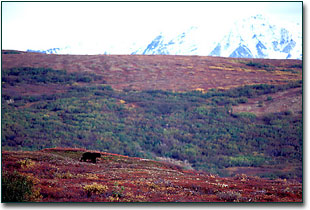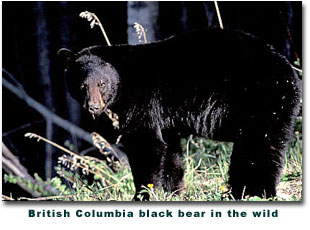A recent discussion in the General Forum brought to mind this incident. I sure wished I’d been carrying “bear spray” that day. That’s not to say that one should do something stupid because you’re packing spray. However, it would have been nice to at least have a last defense – just in case. Catch yours in the good light.
The Mooseman
The Alaskan photographer didn't believe we'd seen a black bear cruising the tundra near Mile 80 of Denali National Park's only road. He asked a bunch of questions. Where did you see the bear? Are you sure it didn't have a hump? Did it have a light colored snout? How did it act? He clearly knew his bears. Part of the reason he doubted us was because he knew that black bears generally avoid home ranges where the grizzlies roam, as grizzlies will prey on their weaker cousins.
 He also knew that Denali National Park offers a population of readily viewable brown bears. Anyone who takes the bus tour through Denali has a good chance of seeing one on any given day. Mike Francis, a wildlife pro from Montana, and I had seen our own share of grizzlies by this time-our third trip to Denali together that September of 1995.
He also knew that Denali National Park offers a population of readily viewable brown bears. Anyone who takes the bus tour through Denali has a good chance of seeing one on any given day. Mike Francis, a wildlife pro from Montana, and I had seen our own share of grizzlies by this time-our third trip to Denali together that September of 1995.
We'd never seen a black bear there before either. Never, that is, until that afternoon on the way to Wonder Lake.
One shouldn't expect to see black bears on the open tundra. Denali Park's official handout, Denali Alpenglow, states: "Black bears inhabit forested areas of the park, while grizzly bears live mainly on the open tundra."
Knowing all of this makes one think that a black bear that survives with grizzlies is either one tough or one crafty bruin - or both. That was what bothered me most when this one began to follow me the next day.
It started with a trek onto the spongy tundra in search of moose. A couple of good moose ponds lie within a mile north of the gravel park road in the vicinity of mile 80. We had decided to set off from different points and join up on the tundra. I dropped Mike off and drove west another mile and parked the truck.
After a half hour trudging through the springy stuff, I spotted Mike coming over the top of one of the many low ridges. As I was about to call to him, the black bear emerged on a ridge a quarter mile behind Mike.
The day was calm and sunny with only a light breeze. The bear, upwind, scoured the distant ridge gorging on a rich crop of blueberries. Black bears aren't known for keen eyesight and this one hadn’t seen us, so I waved and pointed to the bear, afraid that calling would scare it off.
We only had time for a few photographs before the bear worked its way over the ridgeline. While distant, the bear made a decent habitat shot against the red tundra and snow covered mountains. Now no one would doubt we'd seen a black bear. Or would they? Had those frames been sharp, what with a tripod quickly jammed into the tundra? I wanted another chance to photograph the bear.
Denali National Park rules prohibit approaching within a quarter mile of a bear on foot. The rules are worded such that it seems that your potential problem would be with grizzlies. Perhaps no one expects that you'll encounter a black bear at Denali?
Grizzlies do present a greater threat. That’s partly because black bears generally hide at the sight, smell or sound of humans. They’re also not likely to defend cubs or carcasses ferociously.
Never underestimate what a black bear can do! One predacious black bear in Canada killed three teenagers in a single day. As Mike kept searching for moose, I remembered that while climbing the ridge where I hoped to photograph the bear at a safe distance again. I didn't intend to violate any rules or put myself at risk.
I walked up the ridge, expecting to see the bear on the next distant hillside, but the bear was nowhere to be seen. Had it gone over that hill? Or was it still on its lower slope?
As I neared the ridge and still didn't see the bear, I knew it had been a mistake to go after it. What to do? Turn and leave without knowing where it was and perhaps encounter it by surprise? Or go to the top to locate it for sure?
The last course seemed the safest. However,I never expected to find that bear just over the ridge. On the open tundra, a mile from the truck all by myself, I suddenly felt very vulnerable.
 The bear didn’t see me as it busily raked in blueberries. Thoughts tumbled through my brain-maybe you can leave quietly before the bear sees you. But what if it smells or hears you? Or you startle it?
The bear didn’t see me as it busily raked in blueberries. Thoughts tumbled through my brain-maybe you can leave quietly before the bear sees you. But what if it smells or hears you? Or you startle it?
Deciding it was better to be facing the bear when it discovered me, I shoved my tripod-mounted camera into the tundra and stood tall behind it to make the greatest possible impression of size. Then I harrumphed a soft cough.
The bear suddenly stopped eating and looked up. It stared at me for a long time, apparently unconcerned. I risked a shot, thinking that if the worst happens, at least they'll know it was a black bear out here on the tundra where none were supposed to be.
At the click, the bear casually resumed feeding, but it fed closer towards me.
Was this one crafty bruin? I wasn't waiting around to find out. I grabbed my tripod and walked slowly backwards until the bear could no longer see me, then turned and ran ten steps to put distance between us. I repeated that maneuver again and again.
I comforted myself by thinking about how much trouble I might have been in if it was a grizzly. But had it been a grizzly, would I have tried for a second photo opportunity all by myself? No! Never!
That’s when the bear came over the ridge, now 500 feet behind me. I walked faster without running. Running can trigger a predator response. Having made one big mistake, I was determined not to make another.
The bear followed. It kept following for half of that long mile back to the truck before finally stopping on a ridge to lie down and watch me walk away.
Perhaps I never was in danger. Or maybe the bear let me to go because I'd put distance between us. It was probably just testing its dominance. Who really knows? I do know one thing-you should always respect a black bear as much as a grizzly.
Anyone who doubts that, should have one follow them sometime.
Catch yours in the good light.
BS-NPN 012
http://camerahunter.com
Comments on Bill Silliker, Jr.'s The Camera Hunter articles? Send them to the editor.
Maine wildlife & nature photographer Bill Silliker, Jr. – The Mooseman - photographed at many wild places in North America, with the results published in magazines internationally and in 9 of his own books. Bill was an instructor of wildlife and nature photography for L. L. Bean's Outdoor Discovery Program and a member of the Fuji Film Talent Team. Read more about Bill on the Camera Hunter archives page.



